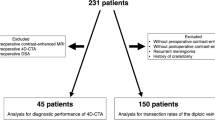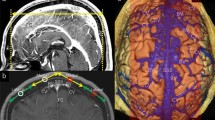Abstract
Background
Although it is known that diploic veins frequently communicate with the dural venous sinuses, the role of diploic veins in patients with venous sinus invasion from meningiomas remains unknown.
Methods
We retrospectively examined the medical records of 159 patients who underwent their first craniotomies for intracranial meningiomas. Contrast-enhanced magnetic resonance imaging was used to evaluate diploic vein routes, and digital subtraction angiography (DSA) was used to evaluate diploic vein blood flow. When high blood flow was visualized concurrently with the venous sinuses, the veins were classified as of the “early type.” Diploic vein routes were classified into five routes.
Results
DSA was performed in 110 patients, with 14 showing superior sagittal sinus (SSS) invasion (SSS group) and 23 showing non-SSS venous sinus invasion (non-SSS group). The proportion of early type diploic veins was significantly higher in the SSS group (27.1%) than in other patients (patients without venous sinus invasion, 2.1%; non-SSS, 4.3%) (p < 0.01). In patients not in the SSS group, diploic veins were sacrificed during craniotomy in 76 patients, including four patients with veins of the early type. No patients demonstrated new neurological deficits postoperatively. In the SSS group, diploic veins were sacrificed in all patients, and early type diploic veins were cut in five patients. Two of these five patients showed postoperative neurological deficits.
Conclusions
In the SSS group, diploic veins may function as collateral venous pathways, and attention is recommended for their interruption. In patients without SSS invasion, diploic veins, even of the early type, can be sacrificed.







Similar content being viewed by others
References
Adachi K, Hayakawa M, Ishihara K, Ganaha T, Nagahisa S, Hasegawa M, Hirose Y (2016) Study of changing intracranial venous drainage patterns in petroclival meningioma. World Neurosurg 92:339–348. https://doi.org/10.1016/j.wneu.2016.05.019
Eisova S, Rangel de Lazaro G, Pisova H, Pereira-Pedro S, Bruner E (2016) Parietal bone thickness and vascular diameters in adult modern humans: a survey on cranial remains. Anat Rec (Hoboken) 299:888–896. https://doi.org/10.1002/ar.23348
Garcia-Gonzalez U, Cavalcanti DD, Agrawal A, Gonzalez LF, Wallace RC, Spetzler RF, Preul MC (2009) The diploic venous system: surgical anatomy and neurosurgical implications. Neurosurg Focus 27:E2. https://doi.org/10.3171/2009.8.FOCUS09169
Hatipoglu HG, Ozcan HN, Hatipoglu US, Yuksel E (2008) Age, sex and body mass index in relation to calvarial diploe thickness and craniometric data on MRI. Forensic Sci Int 182:46–51. https://doi.org/10.1016/j.forsciint.2008.09.014
Hershkovitz I, Greenwald C, Rothschild BM, Latimer B, Dutour O, Jellema LM, Wish-Baratz S, Pap I, Leonetti G (1999) The elusive diploic veins: anthropological and anatomical perspective. Am J Phys Anthropol 108:345–358. https://doi.org/10.1002/(sici)1096-8644(199903)108:3<345::Aid-ajpa9>3.0.Co;2-s
Inui T, Okuno S (2012) Intracranial hemorrhage associated with injury of the critical diploic venous system in clipping for unruptured cerebral aneurysm: a case report. No Shinkei Geka 40:437–444
Jivraj K, Bhargava R, Aronyk K, Quateen A, Walji A (2009) Diploic venous anatomy studied in-vivo by MRI. Clin Anat 22:296–301. https://doi.org/10.1002/ca.20767
Lachkar S, Dols MM, Ishak B, Iwanaga J, Tubbs RS (2019) The diploic veins: a comprehensive review with clinical applications. Cureus 11:e4422. https://doi.org/10.7759/cureus.4422
Leung V, Shemesh AA, Al Shafai L, Krings T, Valiante T, Margolin E (2019) Severe intraoperative orbital venous congestion during resection of a frontal meningioma presenting with post-operative vision loss and ophthalmoplegia: a case report. Neuroophthalmology 43:265–268. https://doi.org/10.1080/01658107.2018.1527856
Mathiesen T, Pettersson-Segerlind J, Kihlstrom L, Ulfarsson E (2014) Meningiomas engaging major venous sinuses. World Neurosurg 81:116–124. https://doi.org/10.1016/j.wneu.2013.01.095
Mizutani K, Akiyama T, Yoshida K, Toda M (2018) Skull base venous anatomy associated with endoscopic skull base neurosurgery: a literature review. World Neurosurg 120:405–414. https://doi.org/10.1016/j.wneu.2018.09.067
Mizutani K, Toda M, Kurasawa J, Akiyama T, Fujiwara H, Jinzaki M, Yoshida K (2017) Analysis of the venous channel within the clivus using multidetector computed tomography digital subtraction venography. Neuroradiology 59:213–219. https://doi.org/10.1007/s00234-017-1784-4
Oka K, Go Y, Kimura H, Tomonaga M (1994) Obstruction of the superior sagittal sinus caused by parasagittal meningiomas: the role of collateral venous pathways. J Neurosurg 81:520–524. https://doi.org/10.3171/jns.1994.81.4.0520
Park J, Hamm IS (2004) Anterior interhemispheric approach for distal anterior cerebral artery aneurysm surgery: preoperative analysis of the venous anatomy can help to avoid venous infarction. Acta Neurochir 146. https://doi.org/10.1007/s00701-004-0304-6
Patel N (2009) Venous anatomy and imaging of the first centimeter. Semin Ultrasound CT MR 30:513–524. https://doi.org/10.1053/j.sult.2009.08.003
Pisova H, Rangel de Lazaro G, Veleminsky P, Bruner E (2017) Craniovascular traits in anthropology and evolution: from bones to vessels. J Anthropol Sci 95:35–65. https://doi.org/10.4436/JASS.95003
Rangel de Lazaro G, de la Cuetara JM, Pisova H, Lorenzo C, Bruner E (2016) Diploic vessels and computed tomography: segmentation and comparison in modern humans and fossil hominids. Am J Phys Anthropol 159:313–324. https://doi.org/10.1002/ajpa.22878
Sindou MP, Alvernia JE (2006) Results of attempted radical tumor removal and venous repair in 100 consecutive meningiomas involving the major dural sinuses. J Neurosurg 105:514–525. https://doi.org/10.3171/jns.2006.105.4.514
Sindou M, Auque J (2000) The intracranial venous system as a neurosurgeon’s perspective. Adv Tech Stand Neurosurg 26:131–216. https://doi.org/10.1007/978-3-7091-6323-8_5
Skrzat J, Brzegowy P, Walocha J, Wojciechowski W (2004) Age dependent changes of the diploe in the human skull. Folia Morphol (Warsz) 63:67–70
Smith KR Jr (1968) Idiopathic bilateral sigmoid sinus occlusion in a child: case report. J Neurosurg 29:427–430. https://doi.org/10.3171/jns.1968.29.4.0427
Tsutsumi S, Nakamura M, Tabuchi T, Yasumoto Y, Ito M (2013) Calvarial diploic venous channels: an anatomic study using high-resolution magnetic resonance imaging. Surg Radiol Anat 35:935–941. https://doi.org/10.1007/s00276-013-1123-3
Tsutsumi S, Ono H, Ishii H, Yasumoto Y (2019) Diploic veins of the cranial base: an anatomical study using magnetic resonance imaging. Surg Radiol Anat 41:1029–1036. https://doi.org/10.1007/s00276-019-02283-y
Yamashiro K, Hasegawa M, Higashiguchi S, Kato H, Hirose Y (2020) Intravenous sinus meningioma with intraluminal extension to the internal jugular vein: case report and review of the literature. Br J Neurosurg 1–6. https://doi.org/10.1080/02688697.2020.1777258
Yokota H, Noguchi H, Yokoyama K (2019) Epidermoid cyst with torcular herophili obstruction and unusual venous drainage. World Neurosurg 128:14–17. https://doi.org/10.1016/j.wneu.2019.04.223
Acknowledgements
We would like to thank Editage for proofreading our work.
Author information
Authors and Affiliations
Contributions
Study conception and design: Kei Yamashiro and Jun Muto. Data collection: Kei Yamashiro and Akira Wakako. Data Analysis; Kei Yamashiro and Akira Wakako. Writing the article: Kei Yamashiro, Jun Muto, Kazuhiro Murayama, and Daijiro Kojima. Revising the article: all authors.
Corresponding author
Ethics declarations
Ethics approval
All procedures performed in studies involving human participants were in accordance with the ethical standards of the institutional and/or national research committee (institutional review board at Fujita health university, Protocol Number: HM19-472) and with the 1964 Helsinki declaration and its later amendments or comparable ethical standards.
Conflict of interest
The authors declare no competing interests.
Additional information
Publisher’s note
Springer Nature remains neutral with regard to jurisdictional claims in published maps and institutional affiliations.
This article is part of the Topical Collection on Tumor - Meningioma
Rights and permissions
About this article
Cite this article
Yamashiro, K., Muto, J., Wakako, A. et al. Diploic veins as collateral venous pathways in patients with dural venous sinus invasion by meningiomas. Acta Neurochir 163, 1687–1696 (2021). https://doi.org/10.1007/s00701-021-04777-4
Received:
Accepted:
Published:
Issue Date:
DOI: https://doi.org/10.1007/s00701-021-04777-4




